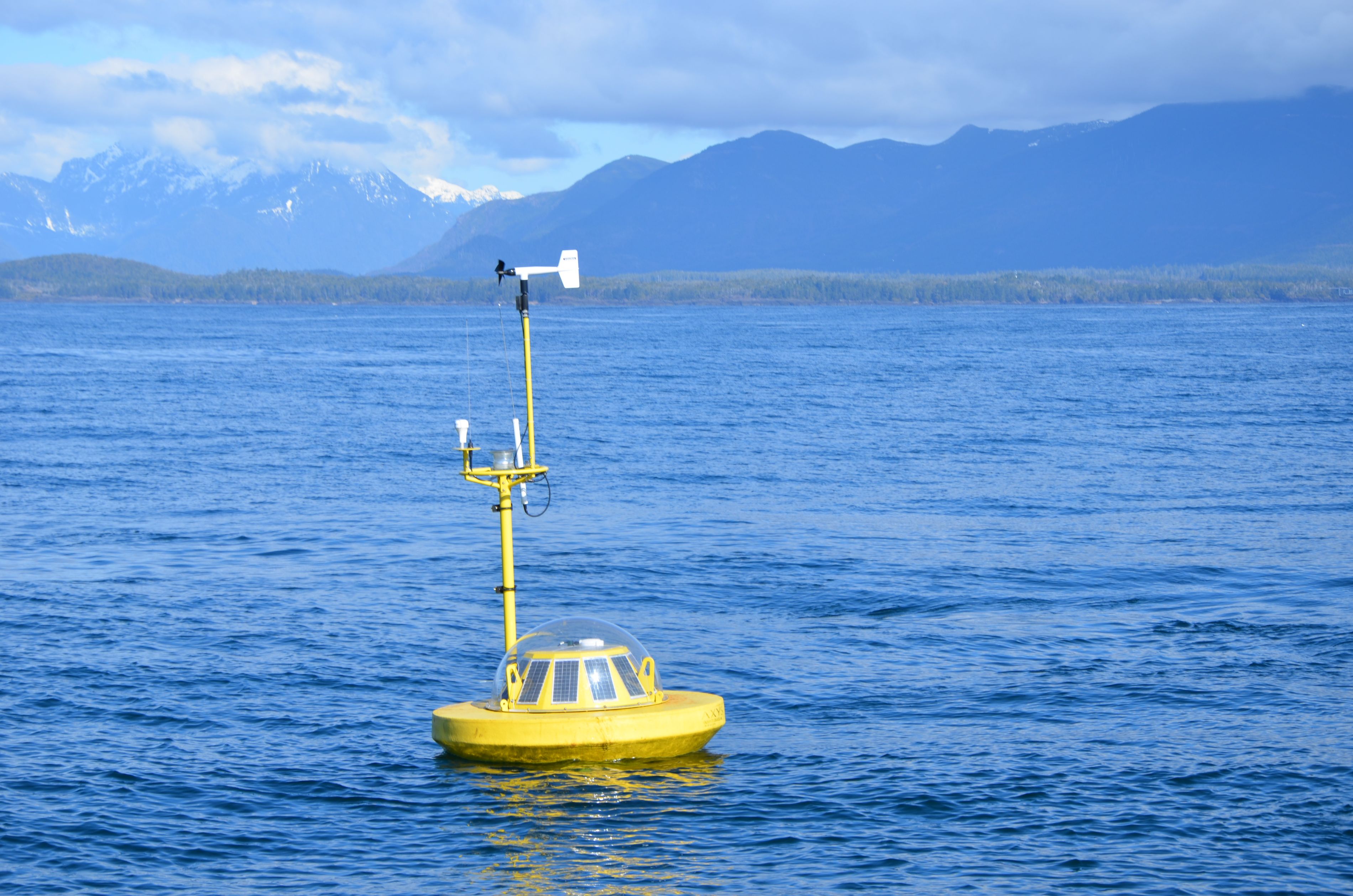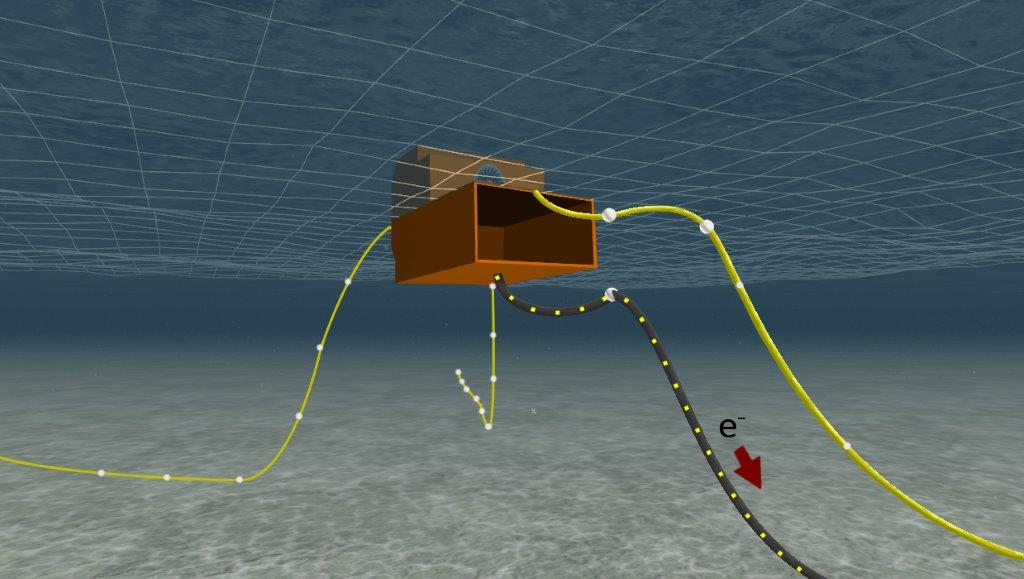West Coast Wave Initiative (WCWI)
West Coast Wave Initiative (WCWI)
Lead Proponent: University of Victoria
Location: Victoria, BC
ecoEII Contribution: $ 1,930,000
Project Total: $3,771,000
Project Background

Beverly Watchmate wave measurement buoy off Ucluelet, BC
Text version
The yellow AXYS Technologies WatchMate buoy moored off the west coast of Vancouver Island. The deployment location is ~ 7km offshore from Ucluelet, BC
The development of the Canadian wave energy industry has historically been hampered by a dearth of sufficiently resolved information about the gross wave energy resource, the net power production from wave energy converters (WECs) in Canadian waters and the impact of usable wave energy integration on electricity grids. The financial impact and personnel requirements to adequately quantify the gross, net and usable wave energy resource are beyond the financial and technical resources of a single developer. Recognizing the need to provide the wave energy industry with the knowledge, tools and data to overcome these barriers, the Institute of Integrated Energy Systems at the University of Victoria conceived the “West Coast Wave Initiative (WCWI)” and put forward the proposal for ecoEII funding. WCWI was awarded $1,930K to build an accurate and precise description Canada’s raw wave resource, the potential of wave energy converters to harness that resource and the means to incorporate power generated by WECs into electrical grids.
Results

A ProteusDS simulation of Ocean Energy Ltd’s Oscillating Water Column WEC, mooring lines and power export cable
Text version
A visualization of Irish WEC developer, Ocean Energy Ltd’s Oscillating Water Column WEC, deployed in BC wave conditions. The image comes from Dynamic Systems Analysis ProteusDS software and includes both mooring lines and a power export cable.
Wave energy resource assessment was performed using three field deployed wave measurement buoys and two differing numerical wave propagation models in order to build a precise picture of wave energy resources off Vancouver Island. The wave measurement buoys were used to gather precise wave energy resource data at high interest locations and to validate the numerical wave propagation model. The wave propagation models included a 40,000 km2 SWAN model for the west coast of Vancouver Island (WCVI) and a smaller, higher fidelity REF/DIF model for Hesquiaht Sound. A 12 year hindcast (2004 – 2015) and 48 hour forecast of wave conditions for the WCVI region was completed.
A suite of modelling tools was developed for four collaborating wave energy technologies: WCWI’s internal self-reacting two body point absorber, Resolute Marine Energy’s oscillating flap, Seawood Designs’ Surfpower float, and Ocean Energy Ltd.’s floating oscillating water column. ProteusDS, Dynamics Systems Analysis’ simulation software, was used to model each device at full scale, and predict its power production for sea state (characterized by statistics from the completed gross wave resource assessment). Coupling of the ProteusDS hydrodynamic software and custom Power Take Off (PTO) models, and implementation of unique control algorithms, produced improved power production and performance metrics. Modelling was validated using experimental wave tank testing data for each design.
The opportunity and impact of integrating WEC-generated power into remote communities and utility-scale grids was quantified. WEC performance data was fed into detailed studies of wave energy integration at three scales: kilowatt, megawatt and gigawatt. The remote community study focussed on the First Nations community of Hot Springs Cove near the Hesquiaht Sound and utilized a unique database of power demand from 2010 to 2011. On Vancouver Island, the integration of ten 50 MW offshore wave energy farms were simulated. The seasonal nature of wave energy was shown have positive correlation with local demand. For large scale integration, WCWI provided the “2060 Project” wave data to help define the long-term pathway to decarbonizing the Western Canadian power system.
Finally, the ProteusDS WEC numerical simulation toolbox was modified in order to model Accumulated Ocean Energy’s (AOE’s) unique pneumatic cascaded WEC and to improve software computational efficiency. A full scale AOE numerical model was developed and tested with a baseline PTO control strategy, including a fully coupled hydrodynamic, pneumatic and thermodynamic model. The numerical architecture of ProteusDS calculations was then updated to improve computational speed and numerical accuracy. A Techno-Economic Analyses of the integration of wave power with other renewable sources and existing electrical systems at remote off-grid communities was conducted.
Benefits for Canada
A hub for innovation in wave energy in Canada has been created - the resulting data and tools provide Canada with insight into the resource and it’s potential. A better understanding of the usable extent of the wave resources off the WCVI will make the region more attractive for WEC developers who are currently focussed on non-Canadian markets. Research findings and best practices have informed the development of International Electrotechnical Commission (IEC) Technical Specifications 62600-100, 62600-101, 62600-102, 62600-30, and 62600-10.
Next Steps
Continue to evolve and improve the tools developed. Support and participate in further R&D to increase the efficiency and lower the associated costs of WEC devices.
Page details
- Date modified: